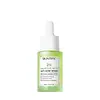What's inside
What's inside
 Key Ingredients
Key Ingredients

 Benefits
Benefits

 Concerns
Concerns

 Ingredients Side-by-side
Ingredients Side-by-side

Water
Skin ConditioningButylene Glycol
HumectantNiacinamide
SmoothingGlycerin
HumectantPPG-10 Methyl Glucose Ether
Skin ConditioningPentylene Glycol
Skin Conditioning1,2-Hexanediol
Skin ConditioningSalicylic Acid
MaskingAcacia Senegal Gum
MaskingAcrylates/C10-30 Alkyl Acrylate Crosspolymer
Emulsion StabilisingTriethanolamine
BufferingMethylpropanediol
SolventEctoin
Skin ConditioningDipotassium Glycyrrhizate
HumectantPlatonin
Skin ConditioningCeramide AP
Skin ConditioningCeramide NP
Skin ConditioningCeramide Ns
Skin ConditioningCentella Asiatica Extract
CleansingDisodium EDTA
Tartaric Acid
BufferingMalic Acid
BufferingPeumus Boldus Leaf Extract
MaskingPPG-26-Buteth-26
Skin ConditioningAllantoin
Skin ConditioningO-Cymen-5-Ol
AntimicrobialEthylhexylglycerin
Skin ConditioningGlyceryl Caprylate
EmollientPEG-40 Hydrogenated Castor Oil
EmulsifyingMenthol
MaskingCaprylyl Glycol
EmollientXanthan Gum
EmulsifyingHydrolyzed Royal Jelly Protein
Skin ConditioningOligopeptide-1
Skin ConditioningSodium Hyaluronate
HumectantGlycolipids
Skin ConditioningGlycosphingolipids
EmollientPropanediol
SolventSodium Lactate
BufferingGlycolic Acid
BufferingSucrose
HumectantUrea
BufferingSodium Citrate
BufferingPhenoxyethanol
PreservativeWater, Butylene Glycol, Niacinamide, Glycerin, PPG-10 Methyl Glucose Ether, Pentylene Glycol, 1,2-Hexanediol, Salicylic Acid, Acacia Senegal Gum, Acrylates/C10-30 Alkyl Acrylate Crosspolymer, Triethanolamine, Methylpropanediol, Ectoin, Dipotassium Glycyrrhizate, Platonin, Ceramide AP, Ceramide NP, Ceramide Ns, Centella Asiatica Extract, Disodium EDTA, Tartaric Acid, Malic Acid, Peumus Boldus Leaf Extract, PPG-26-Buteth-26, Allantoin, O-Cymen-5-Ol, Ethylhexylglycerin, Glyceryl Caprylate, PEG-40 Hydrogenated Castor Oil, Menthol, Caprylyl Glycol, Xanthan Gum, Hydrolyzed Royal Jelly Protein, Oligopeptide-1, Sodium Hyaluronate, Glycolipids, Glycosphingolipids, Propanediol, Sodium Lactate, Glycolic Acid, Sucrose, Urea, Sodium Citrate, Phenoxyethanol
 Reviews
Reviews

Ingredients Explained
These ingredients are found in both products.
Ingredients higher up in an ingredient list are typically present in a larger amount.
1,2-Hexanediol is a synthetic liquid and another multi-functional powerhouse.
It is a:
- Humectant, drawing moisture into the skin
- Emollient, helping to soften skin
- Solvent, dispersing and stabilizing formulas
- Preservative booster, enhancing the antimicrobial activity of other preservatives
Allantoin is a soothing ingredient known for its protective and moisturizingg properties. Because of this, it is often added to products with strong active ingredients.
Studies show higher concentrations of this ingredient can promote wound healing.
Though it can be derived from the comfrey plant, allantoin is produced synthetically for cosmetic products to ensure purity.
Learn more about AllantoinCentella Asiatica Extract (Centella) is derived from an herb native to Southeast Asia. It is famous for its anti-inflammatory and soothing properties.
Centella is rich in antioxidants and amino acids, such as Madecassic Acid and Asiaticoside.
Studies show the compounds in centella help with:
The combination of all these properties makes centella effective at soothing, hydrating, and protecting the skin.
Other great components of centella include Vitamin A, vitamin C, several B vitamins, and Asiatic Acid.
Fun fact: Centella has been used as a medicine and in food for many centuries. As a medicine, it is used to treat burns, scratches, and wounds.
Learn more about Centella Asiatica ExtractGlycerin is already naturally found in your skin. It helps moisturize and protect your skin.
A study from 2016 found glycerin to be more effective as a humectant than AHAs and hyaluronic acid.
As a humectant, it helps the skin stay hydrated by pulling moisture to your skin. The low molecular weight of glycerin allows it to pull moisture into the deeper layers of your skin.
Hydrated skin improves your skin barrier; Your skin barrier helps protect against irritants and bacteria.
Glycerin has also been found to have antimicrobial and antiviral properties. Due to these properties, glycerin is often used in wound and burn treatments.
In cosmetics, glycerin is usually derived from plants such as soybean or palm. However, it can also be sourced from animals, such as tallow or animal fat.
This ingredient is organic, colorless, odorless, and non-toxic.
Glycerin is the name for this ingredient in American English. British English uses Glycerol/Glycerine.
Learn more about GlycerinMethylpropanediol is a synthetic solvent and humectant.
As a solvent, it helps dissolve other ingredients, helping to evenly distribute ingredients throughout the product. This ingredient has also been shown to have antimicrobial properties which makes it a preservative booster.
Methylpropanediol is able to add a bit of moisture to the skin. It also helps other ingredients be better absorbed into the skin, such as salicylic acid.
Learn more about MethylpropanediolThis ingredient is more commonly known as IPMP or Isopropyl Methylphenol. It is a preservative and has antimicrobial properties.
According to the EPA, this ingredient is allowed for use in cleansers, creams, powders, bath products, toothpaste, perfume, and more.
Salicylic Acid (also known as beta hydroxy acid or BHA) is a well-known ingredient for treating skin that struggles with acne and clogged pores. It exfoliates both the skin's surface and deep within the pores to help clear out buildup, control oil, and reduce inflammation.
Unlike AHAs (alpha hydroxy acids), salicylic acid is oil-soluble. This allows it to penetrate into pores which makes it especially effective for treating blackheads and preventing future breakouts.
Salicylic acid is also known for its soothing properties. It has a similar structure to aspirin and can calm inflamed or irritated skin, making it a good option for acne-prone skin that is also sensitive.
Concentrations of 0.5-2% are recognized by the U.S. FDA as an over-the-counter topical acne product.
It can cause irritation and/or dryness if one's skin already has a compromised moisture barrier, so it's best to focus on repairing that before introducing this ingredient into your routine.
While salicylic acid does not increase sun sensitivity, it’s still important to wear sunscreen daily to protect your skin.
If you are looking for the ingredient called BHA or Butylated Hydroxyanisole, click here.
Learn more about Salicylic AcidWater. It's the most common cosmetic ingredient of all. You'll usually see it at the top of ingredient lists, meaning that it makes up the largest part of the product.
So why is it so popular? Water most often acts as a solvent - this means that it helps dissolve other ingredients into the formulation.
You'll also recognize water as that liquid we all need to stay alive. If you see this, drink a glass of water. Stay hydrated!
Learn more about Water